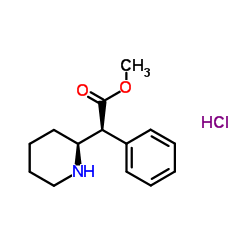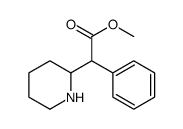298-59-9
| Name | methylphenidate hydrochloride |
|---|---|
| Synonyms |
Methyl 2-phenyl-2-(piperidin-2-yl)acetate hydrochloride
Methyl (2S)-phenyl[(2S)-2-piperidinyl]acetate hydrochloride (1:1) Ciba 4311b Concerta Methylphenidate hydrochloride EINECS 206-065-3 Methyl phenyl(2-piperidinyl)acetate hydrochloride (1:1) 2-Piperidineacetic acid, α-phenyl-, methyl ester, hydrochloride (1:1) Metadate Methyl a-Phenyl-a-(2-piperidyl)acetate Hydrochloride METHYLPHENIDATE.HCl a-Phenyl-a-(2-piperidyl)acetic Acid Methyl Ester Hydrochloride 2-Piperidineacetic acid, α-phenyl-, methyl ester, (αS,2S)-, hydrochloride (1:1) a-Phenyl-2-piperidineacetic Acid Methyl Ester Hydrochloride Methyl α-phenyl-2-piperidineacetate hydrochloride Methyl phenyl(piperidin-2-yl)acetate hydrochloride (1:1) methylphenidate HCl MFCD00058191 2-Piperidineacetic acid, α-phenyl-, methyl ester, hydrochloride Ritalin hydrochloride |
| Boiling Point | 327.6ºC at 760 mmHg |
|---|---|
| Melting Point | 224 - 226ºC |
| Molecular Formula | C14H20ClNO2 |
| Molecular Weight | 269.767 |
| Flash Point | 152ºC |
| Exact Mass | 269.118256 |
| PSA | 38.33000 |
| LogP | 3.21610 |
| Vapour Pressure | 0.000199mmHg at 25°C |
| Index of Refraction | 1.523 |
| Storage condition | Store at RT |
| Stability | Stable. Combustible. Incompatible with strong oxidizing agents, alkalies, barbiturates. |
|
Section 1. Chemical Product and Company Identification Methylphenidate Hydrochloride Common Name/ Trade Name Manufacturer Commercial Name(s) Synonym
Chemical Name Chemical Family Methylphenidate Hydrochloride Section 4. First Aid Measures Eye ContactCheck for and remove any contact lenses. In case of contact, immediately flush eyes with plenty of water for at least 15 minutes. Cold water may be used. Get medical attention if irritation occurs. Skin ContactWash with soap and water. Cover the irritated skin with an emollient. Get medical attention if irritation develops. Cold water may be used. Serious Skin ContactNot available. InhalationIf inhaled, remove to fresh air. If not breathing, give artificial respiration. If breathing is difficult, give oxygen. Get medical attention. Serious InhalationNot available. IngestionDo NOT induce vomiting unless directed to do so by medical personnel. Never give anything by mouth to an unconscious person. If large quantities of this material are swallowed, call a physician immediately. Loosen tight clothing such as a collar, tie, belt or waistband. Serious IngestionNot available. Section 5. Fire and Explosion Data Flammability of the Product May be combustible at high temperature. Auto-Ignition Temperature 550°C (1022°F) Flash PointsNot available. Flammable LimitsNot available. These products are carbon oxides (CO, CO2), nitrogen oxides (NO, NO2...). Products of Combustion Fire Hazards in Presence of Slightly flammable to flammable in presence of heat. Various SubstancesNon-flammable in presence of open flames and sparks. Explosion Hazards in Presence Slightly explosive in presence of open flames and sparks. of Various SubstancesNon-explosive in presence of shocks. Fire Fighting MediaSMALL FIRE: Use DRY chemical powder. and InstructionsLARGE FIRE: Use water spray, fog or foam. Do not use water jet. Special Remarks onAs with most organic solids, fire is possible at elevated temperatures Fire Hazards Special Remarks on Explosion Fine dust dispersed in air in sufficient concentrations, and in the presences of an ignition source is a potential dust Hazardsexplosion hazard. Section 6. Accidental Release Measures Small SpillUse appropriate tools to put the spilled solid in a convenient waste disposal container. Finish cleaning by spreading water on the contaminated surface and dispose of according to local and regional authority requirements. Large Spill Use a shovel to put the material into a convenient waste disposal container. Finish cleaning by spreading water on the contaminated surface and allow to evacuate through the sanitary system. Methylphenidate Hydrochloride Section 7. Handling and Storage PrecautionsKeep away from heat. Keep away from sources of ignition. Ground all equipment containing material. Do not ingest. Do not breathe dust. Wear suitable protective clothing. In case of insufficient ventilation, wear suitable respiratory equipment. If ingested, seek medical advice immediately and show the container or the label. Keep away from incompatibles such as alkalis. StorageKeep container tightly closed. Keep container in a cool, well-ventilated area. Section 8. Exposure Controls/Personal Protection Engineering ControlsUse process enclosures, local exhaust ventilation, or other engineering controls to keep airborne levels below recommended exposure limits. If user operations generate dust, fume or mist, use ventilation to keep exposure to airborne contaminants below the exposure limit. Personal ProtectionSafety glasses. Lab coat. Dust respirator. Be sure to use an approved/certified respirator or equivalent. Gloves. Personal Protection in Case of Splash goggles. Full suit. Dust respirator. Boots. Gloves. A self contained breathing apparatus should be used a Large Spillto avoid inhalation of the product. Suggested protective clothing might not be sufficient; consult a specialist BEFORE handling this product. Exposure LimitsNot available. Section 9. Physical and Chemical Properties Physical state and appearance Solid.OdorOdorless. Not available. Taste Molecular Weight269.77 g/mole White. Color Not available. pH (1% soln/water) Boiling PointNot available. Melting Point224°C (435.2°F) Critical TemperatureNot available. Specific GravityNot available. Not applicable. Vapor Pressure Vapor DensityNot available. Not available. Volatility Odor ThresholdNot available. Water/Oil Dist. Coeff.Not available. Ionicity (in Water)Not available. Dispersion PropertiesSee solubility in water, methanol. SolubilityEasily soluble in cold water, methanol. Very slightly soluble in acetone. Soluble in alcohol. Slightly soluble in Chloroform. Methylphenidate Hydrochloride Section 10. Stability and Reactivity Data The product is stable. Stability Instability TemperatureNot available. Heat, incompatible materials Conditions of Instability Reactive with alkalis. Incompatibility with various substances CorrosivityNot available. Special Remarks onNot available. Reactivity Special Remarks onNot available. Corrosivity PolymerizationWill not occur. Section 11. Toxicological Information Routes of EntryAbsorbed through skin. Inhalation. Ingestion. Toxicity to AnimalsAcute oral toxicity (LD50): 60 mg/kg [Mouse]. Chronic Effects on Humans May cause damage to the following organs: cardiovascular system, central nervous system (CNS). Other Toxic Effects onHazardous in case of ingestion, of inhalation. HumansSlightly hazardous in case of skin contact (irritant, sensitizer, permeator). Special Remarks onNot available. Toxicity to Animals Special Remarks onMay cause cancer based on animal test data. Chronic Effects on Humans May affect genetic material (mutagenic) Special Remarks on otherAcute Potential Health Effects: Toxic Effects on HumansSkin: May cause skin irritation. It may be absorbed through broken skin. Eyes: May cause eye irritation. Inhalation: May cause respiratory tract irritation and cause sneezing, coughing, hypersensitivity and other symptoms similar to ingestion. Ingestion: Harmful if swallowed. It is a narcotic. It may cause nausea, stomach pain, dry mouth, and vomiting. It may affect behavior/central nervous system, cardiovascular system, urinary system, brain, liver, blood. Other adverse health effects may include: fast heartbeat, heart palpitations, increased blood pressure, irregular heart beat, bruising, skin rash, fever, sweating, loss of appetite, uncontrolled movements, joint pain, nervousness, dizziness, sleepiness, agitiation, insomnia, confusion, tremors, muscle twitching, delirium, hallucinations, sense of well-being, convulsions possibly followed by coma. Chronic Potential Health Effects: Skin: Repeated or prolonged skin contact may cause hypersensitivity. Ingestion: Repeated or prolonged ingestion may cause habituation or addiction. Prolonged or repeated ingestion may also cause sensitization (hypersensitivity) and develop skin rashes, coughs, stuffy nose, asthma, and other allergic reactions. Hypersensitivity may develop immediately after contact or after years of exposure. Prolonged ingestion may also cause weight loss. Medical conditions aggravated by exposure: severe anxiety, tension or agitation, severe depression, glaucoma, motor tics, Tourette's Syndrome, and high blood pressure. Methylphenidate Hydrochloride Section 12. Ecological Information EcotoxicityNot available. BOD5 and CODNot available. Products of BiodegradationPossibly hazardous short term degradation products are not likely. However, long term degradation products may arise. The products of degradation are less toxic than the product itself. Toxicity of the Products of Biodegradation Special Remarks on theNot available. Products of Biodegradation Section 13. Disposal Considerations Waste DisposalWaste must be disposed of in accordance with federal, state and local environmental control regulations. Section 14. Transport Information DOT ClassificationNot a DOT controlled material (United States). Not applicable. Identification Not applicable. Special Provisions for Transport DOT (Pictograms) Section 15. Other Regulatory Information and Pictograms No products were found. Federal and State Regulations CaliforniaCalifornia prop. 65: This product contains the following ingredients for which the State of California has found to cause cancer which would require a warning under the statute: No products were found. Proposition 65 Warnings California prop. 65: This product contains the following ingredients for which the State of California has found to cause birth defects which would require a warning under the statute: No products were found. Other RegulationsOSHA: Hazardous by definition of Hazard Communication Standard (29 CFR 1910.1200). EINECS: This product is on the European Inventory of Existing Commercial Chemical Substances. WHMIS (Canada) Not controlled under WHMIS (Canada). Other Classifications DSCL (EEC)R22- Harmful if swallowed.S2- Keep out of the reach of children. S46- If swallowed, seek medical advice immediately and show this container or label. Health Hazard HMIS (U.S.A.)2 National Fire Protection 1 Flammability 1 Association (U.S.A.) Fire Hazard 2 0 Reactivity Health Reactivity 0 Specific hazard Personal Protection E Methylphenidate Hydrochloride WHMIS (Canada) (Pictograms) DSCL (Europe) (Pictograms) TDG (Canada) (Pictograms) ADR (Europe) (Pictograms) Protective Equipment Gloves. Lab coat. Dust respirator. Be sure to use an approved/certified respirator or equivalent. Methylphenidate Hydrochloride All chemicals may pose unknown hazards and should be used with caution. This Material Safety Data Sheet (MSDS) applies only to the material as packaged. If this product is combined with other materials, deteriorates, or becomes contaminated, it may pose hazards not mentioned in this MSDS. It shall be the user's responsibility to develop proper methods of handling and personal protection based on the actual conditions of use. While this MSDS is based on technical data judged to be reliable, Spectrum Quality Products, SECTION 16 - ADDITIONAL INFORMATION N/A |
CHEMICAL IDENTIFICATION
HEALTH HAZARD DATAACUTE TOXICITY DATA
MUTATION DATA
|
| Symbol |


GHS07, GHS08 |
|---|---|
| Signal Word | Danger |
| Hazard Statements | H302-H334 |
| Precautionary Statements | P261-P342 + P311 |
| Personal Protective Equipment | dust mask type N95 (US);Eyeshields;Faceshields;Gloves |
| Hazard Codes | Xn: Harmful; |
| Risk Phrases | R22;R42 |
| Safety Phrases | 22-26-36 |
| RIDADR | UN 3249 |
| WGK Germany | 3 |
| RTECS | TM3850000 |
| Packaging Group | III |
| Hazard Class | 6.1(b) |
| HS Code | 2933399090 |
| HS Code | 2933399090 |
|---|---|
| Summary | 2933399090. other compounds containing an unfused pyridine ring (whether or not hydrogenated) in the structure. VAT:17.0%. Tax rebate rate:13.0%. . MFN tariff:6.5%. General tariff:20.0% |

